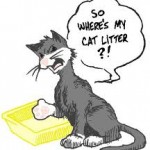Ahhh. leather. We all love it. The sure feel of a leather-covered steering wheel, the confidence of wearing a stylish leather jacket, the sexy look of a leather mini-skirt, the comfort of a sheepskin vest, the caress of soft suede gloves, the power of studded motorcycle saddle-bags, the delicious feeling of a crotch-less leather. Ooops, got a little carried away there!!
This year’s fall & winter fashion statement, leather is turning up everywhere. How do we take care of our not-so-cheap purchases? We at Howtocleananything.com thought you’d like a brief primer about the types of leather out there and, more importantly, how to take care of your investment.
Let’s start out with the 4 basic types of leather:
1) Cowhide – Very strong & durable; used mostly for foot-ware & bags.
2) Calfskin – Lightweight with a pebbly grain; most common type for all sorts of clothing.
3) Lambskin – Also lightweight, with a pliant, soft feel; 30% to 50% more expensive than regular leather; often has wool still attached; skin is rougher and more pebbly.
4) Suede – The underside of the hide; buff finish; most supple of all skins. Now, these are the different finishes commonly found on many garments (with basic cleaning instructions):
1) Distressed – Uneven surface coloration to make it appear weathered; garments look better as they age; wipe with a lightly dampened rag.
2) Embossed – A print is heat pressed onto the surface (usually alligator or snake); can be cow or sheep skin; often with a patent finish; dry clean only.
3) Glazed – Polished using heated rollers; stiff with a nice luster; gently wipe with a damp cloth.
4) Metallic – Sprayed on coating often with foil; shiny delicate surface; light soiling can be gently wiped with a damp chamois; for further cleaning use a professional.
5) Patent – Another sprayed on finish; very tough, high shine, easily repels dirt & moisture; use a damp cloth (with a tiny bit of mild detergent if needed) to wipe clean.
6) Pearlized – A light sprayed-on finish often found on beige or white skins; pearly, shiny look; a delicate surface that only can stand a very light damp chamois; otherwise take it to a professional.
Finally, here are some general guidelines about leather care;
· Use a leather protective spray. Put it on before you use the article. Follow the instructions – be sure to test it an inconspicuous area.
· Hang leather garments on the proper instruments: padded & wide hangers, wood pants presses, ribbon loops to cinch at the waist.
· If the garment is wet, blot dry & hang on a padded hanger at room temperature.
· Never, ever, store leather clothes inside plastic bags or wrapping.
· Be very cautious when ironing any leather article. If needed, use a low heat setting, no steam and put a brown paper bag under the iron. Only go over each area for a few seconds.
· If you are ever in doubt as to how to clean a leather garment, ALWAYS consult with an expert.
Hopefully, you now, don’t have to have a cow, over your leather goods. Don’t be sheepish about how to care for your jackets & coats. We hope this article steers you in the right direction. Per-suede all your friends to heed our advice. Stop my hide-ous comments.

